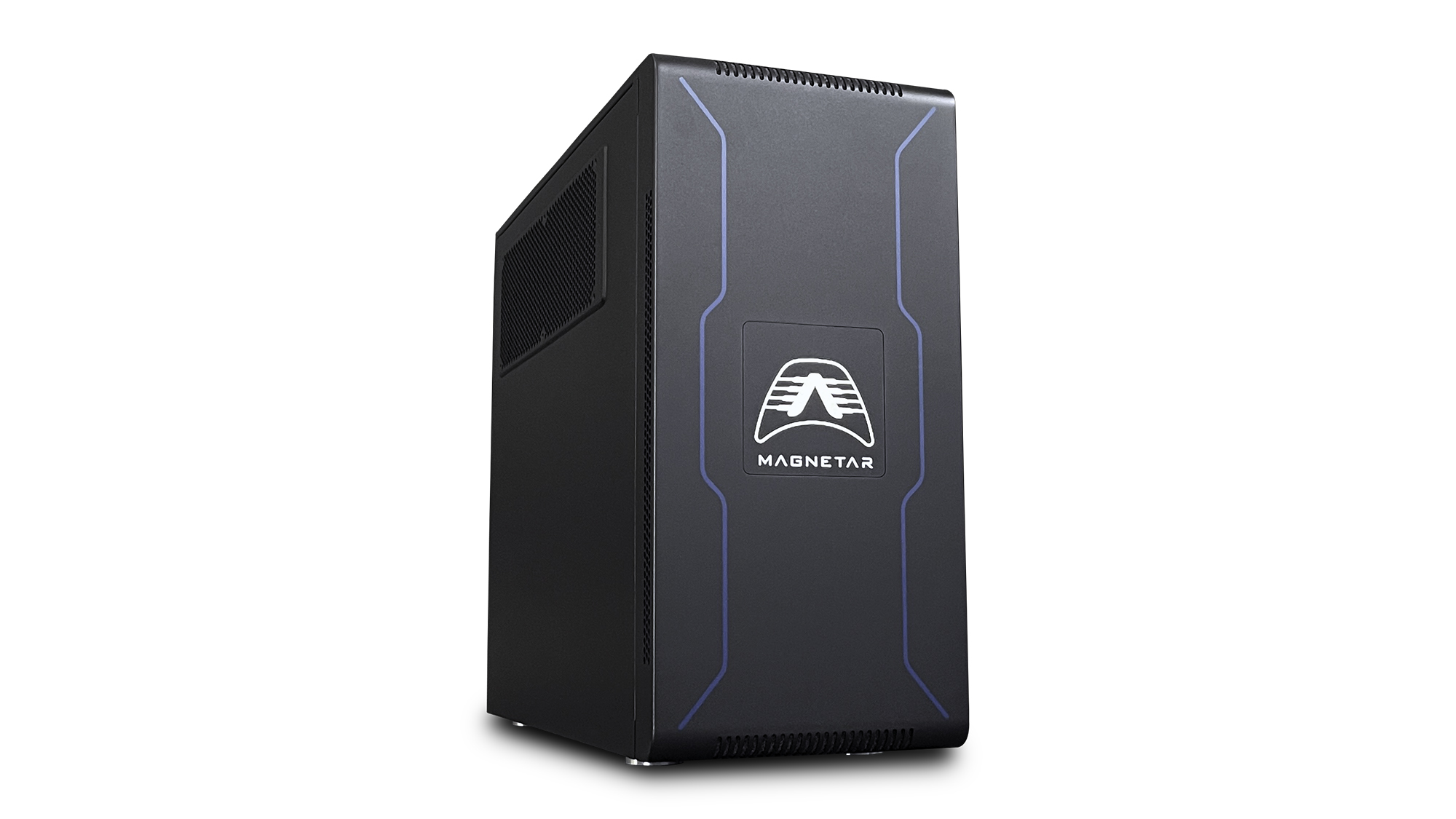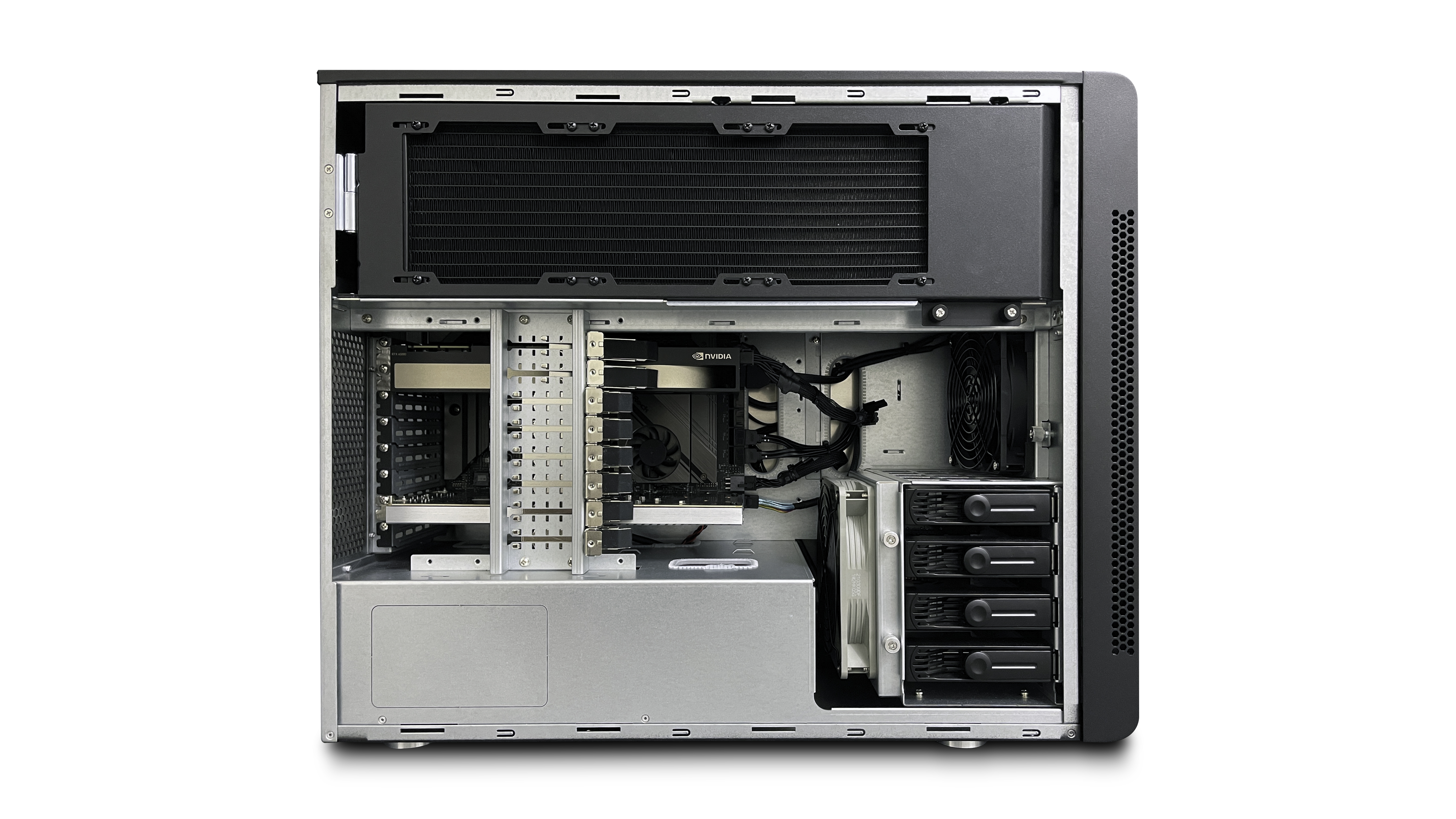Armari Magnetar M64TP-RW2000G3 review: Don’t call it a comeback
The Threadripper Pro arrives just in time to retain AMD’s crown as king of workstation processors


-
+
Fantastic performance
-
+
Future-proof specification
-
+
Whisper-quiet
-
+
RAID0 storage
-
-
None

Just when it looked like AMD was out, it’s pulled the workstation market right back in. The end of the AMD Ryzen and Ryzen Threadripper’s dominance - thanks in part to the 12th generation Intel Core i9 - has been halted by the arrival of the Ryzen Threadripper Pro 5000 series. Armari’s Magnetar M64TP-RW2000G3 shows how much potential this workstation-class Zen 3 processor has.
The exact CPU in question is the Threadripper Pro 5975WX. It might seem a little odd that this is a 32-core processor in a system costing nearly £9,000 when last year we were seeing 64-core processors in systems under £8,000, but the Threadripper Pro always was more expensive than the vanilla Threadripper, and inflation in chip prices hasn’t helped. As we’ll see, 32 cores are plenty, and the 5975X will run these cores at a base 3.6GHz up to 4.5GHz in Boost mode. AMD’s Precision Boost Overdrive can run as many cores as fast as your cooling and motherboard will allow. And talking of cooling, this proved to be an extremely quiet system thanks to the custom cooler.
One area where AMD has allowed Intel to keep the lead is in memory support. The Threadripper Pro only supports DDR4, but it also enables eight channels, theoretically doubling the bandwidth over quad-channel. Armari supplies eight 16GB 3,600MHz modules for a total of 128GB. There are no DIMM slots left free, but 128GB should be enough for most workloads during the lifetime of the machine.
Armari has matched this potent processor and memory combination with a fittingly high-end GPU. The PNY Nvidia Quadro RTX A5000 goes a notch above the A4500 seen in many rival systems like the Scan 3XS GWP-ME A124C by offering 8,192 CUDA cores and 24GB of GDDR6 frame buffer running on a 384-bit bus. This enables 768GB/sec of bandwidth – the same as the even higher-end A5500 and A6000.
The storage provision is unique in that, while there are two drives, the configuration isn’t one for the OS and apps, with the other for data. Instead, Armari supplies a matched pair of 2TB Western Digital SN850 PCI-E Gen 4 SSDs in a RAID0 setup via a PCI-E adapter card, to improve throughput. This essentially doubled read and write speeds over a single drive, hitting 14,015MB/sec reading in CrystalDiskMark 8 and 9,989MB/sec writing. That’s phenomenally fast, as if Gen 4 NVMe SSDs weren’t quick enough already.

Benchmark results show just how potent the 5000 series Threadripper Pro is compared to anything Intel currently has to offer above 16 cores. An overall score in IT Pro’s benchmarks of 753 is the highest we’ve ever seen, led by an incredible 948 in multitasking and 716 in video encoding. The score of 242 in image editing also shows that single-core performance isn’t quite as high as the 12th generation Intel Core i9 can muster, and this is also clear from the single-core result in Maxon Cinebench R23 of 1,493.
Multithreading is where 3D rendering is really at, though, and the Cinebench R23 score here of 50,699 blows everything we’ve tested before out the water. It’s 27% faster than the dual 24-core Xeons in the PCSpecialist Onyx Goliath can deliver, and they have 50% more cores. Just to hammer this home, the Armari took 206 seconds to render the Blender frame while the Xeon-based PCSpecialist took 290 seconds. That’s 40% longer.
Sign up today and you will receive a free copy of our Future Focus 2025 report - the leading guidance on AI, cybersecurity and other IT challenges as per 700+ senior executives
So this system has amazing everyday workload and 3D rendering abilities. It’s also masterful with 3D modelling, looking at the SPECviewperf 2020 results. The Nvidia Quadro RTX A5000 delivered 172 and 489 in 3dsmax-07 and maya-06, showing immense abilities with animations, while 139 in catia-04, 167 in creo-03, 492 in snx-04 and 327 in solidworks-05 illustrate great ability with CAD, engineering and product design.
Overall, this is a workstation without any weaknesses. Whichever creative task you throw it, it will deliver faster results than any other system we’ve seen, making it a worthy award winner. AMD is back - if it even went away in the first place.
Armari Magnetar M64TP-RW2000G3 specifications
| Processor | AMD Ryzen Threadripper Pro 5975WX |
| Motherboard | ASRock WRX80 Creator |
| Expansion slots | 7 |
| RAM | 128GB DDR4 3,600MHz |
| GPU | PNY Nvidia Quadro RTX A5000 24GB GDDR6 |
| Outputs | 4 x DisplayPort 1.4 |
| SSD | 2TB Western Digital SN850 |
| Secondary drives | 2TB Western Digital SN850 |
| Optical drives | N/A |
| Dimensions (WDH) | 220 x 570 x 470mm |
| PSU make and model (power output) | EVGA SuperNova 2000 G+ (2,000W) |
| CPU cooler | Armari Threadripper CIO 360mm 500W Water Cooler |
| Rear ports | 2 x USB 4/Thunderbolt 4, 4 x USB 3.2 Gen 2, 2 x USB 3.2 Gen 1, 2 x 10Gb Ethernet, 5 x 3.5mm audio jack, optical S/PDIF |
| Front/top ports | 3.5mm audio jack, 3.5mm mic jack, 2 x USB-A 3.2 Gen 1, USB-C 3.2 Gen 2 |
| Operating system | Windows 11 Pro 64-bit |
| Warranty (parts & labour unless stated) | 1yr C&R plus 2yr RTB |
Dr James Morris has worked as a technology journalist for over 25 years, including spending nine years on the staff of market-leading computer magazine PC Pro, the last five of which were as the publication’s editor. He specialises in enterprise-grade software and hardware, with a particular focus on content creation. He launched a pioneering video channel for HEXUS.net in 2006 and ran the video reviews channel for TrustedReviews.com for four years. He also runs a successful online digital content and commercial video production company, t-zero communications Ltd.
Dr Morris is a prolific technology writer and contributes commercial content for major IT brands including AMD, BlackBerry, Dell, Cognizant, HP, and IBM. He published a book on artificial intelligence, Can Computers Create Art? in 2009. He is also an academic, and is currently Pathway Director of the MA, Interactive Journalism at City, University of London.
Previously, he was course leader for the BA in Web Media Production at Ravensbourne University. He has a PhD in Philosophy, Art and Social Thought from the European Graduate School in Switzerland, a Master's in Media Arts from the New School in New York, USA, and a Bachelor's in Social Anthropology from the London School of Economics.
Dr. Morris can be found on Twitter at @Cyberwest, or emailed at j@tzero.co.uk
-
 Trump's AI executive order could leave US in a 'regulatory vacuum'
Trump's AI executive order could leave US in a 'regulatory vacuum'News Citing a "patchwork of 50 different regulatory regimes" and "ideological bias", President Trump wants rules to be set at a federal level
By Emma Woollacott Published
-
 Microsoft Excel is still alive and kicking at 40 – and it's surging in popularity as 82% of finance professionals report ‘emotional attachment’ to the spreadsheet software
Microsoft Excel is still alive and kicking at 40 – and it's surging in popularity as 82% of finance professionals report ‘emotional attachment’ to the spreadsheet softwareNews A recent survey found Gen Z and Millennial finance professionals have a strong “emotional attachment” to Microsoft Excel
By Emma Woollacott Published
-
 LastPass hit with ICO fine after 2022 data breach exposed 1.6 million users – here’s how the incident unfolded
LastPass hit with ICO fine after 2022 data breach exposed 1.6 million users – here’s how the incident unfoldedNews The impact of the LastPass breach was felt by customers as late as December 2024
By Emma Woollacott Published
